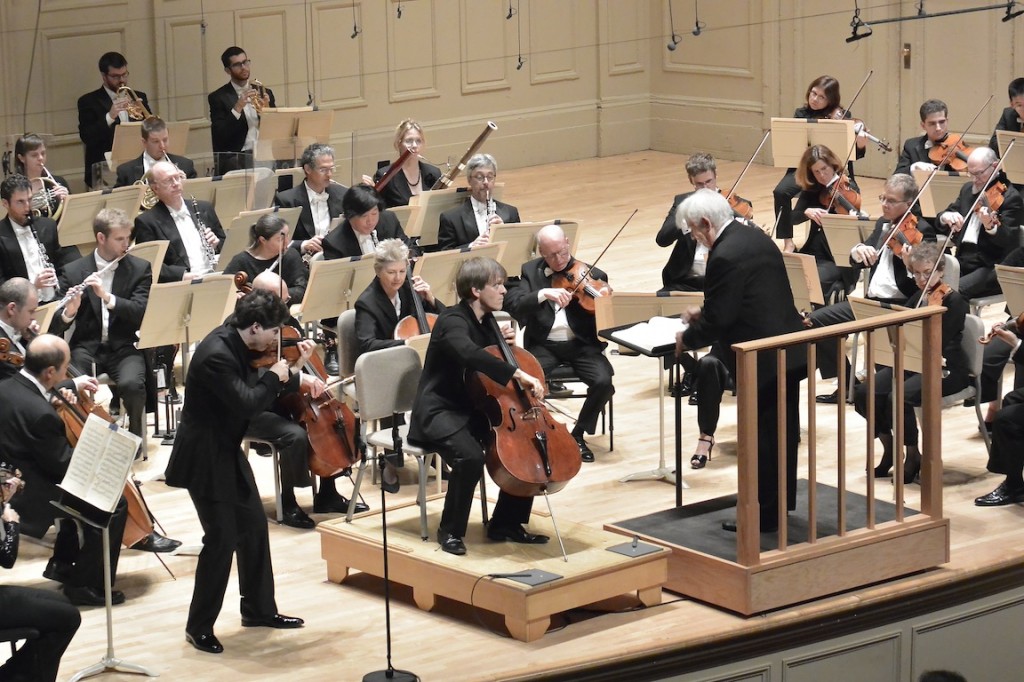Dohnányi, string soloists reflect on Brahms in seriously festive BSO opener

Augustin Hadelich and Alban Gerhardt perform Brahms’ Double Concerto with Christoph von Dohnanyi and the BSO Saturday night at Symphony Hall. Photo: Stu Rosner
As a young maestro wended his way toward the Hub through a forest of prior commitments, the Boston Symphony Orchestra opened yet another music-directorless season—its last for a while, one hopes—with an elder statesman, Christoph von Dohnányi, on the podium Saturday night.
Although Andris Nelsons was not yet on hand to take charge of his new band, youth was still served in the all-Brahms program by the presence of two soloists from the music director-designate’s generation: violinist Augustin Hadelich and cellist Alban Gerhardt, playing Brahms’s “Double” Concerto.
Brahms’s music is a favorite with audiences, but the choice of it for opening night signaled an occasion that would be more reflective than festive. Though composed as a peace offering to an estranged old friend (the violinist Joseph Joachim), the Double Concerto may be the craggiest valentine ever penned.
And the Second Symphony, the blithe product of a summer vacation (instead of a decade-plus of exertion, like the First), still passes through plenty of those dark places that this composer never seemed to escape entirely.
In the temple-like setting of Symphony Hall, conductor and soloists approached their tasks rather self-effacingly. Cellist Gerhardt in particular seemed unconcerned whether his precise, nuanced playing carried much beyond the lip of the stage, and several times his sound was swallowed in the gleam of the BSO woodwinds.
Sonically, the violinist always has the advantage in this combination, and Hadelich needed little effort to let his sweet, slender tone float above his fellow soloist and the orchestra. (One can’t help wondering whether the presence of several microphones directly in front of them unconsciously affected the soloists’ attitude toward projecting into the hall.)
There was plenty of imagination and vigor in the soloists’ opening cadenzas, and one sensed that there were several points in the performance that might have bloomed a bit more if it hadn’t been for Dohnányi’s no-nonsense approach to the score.
The conductor chose to make the most of the work’s sharp elbows—the Beethovenian stressed upbeats, the aggressively displaced rhythms. The clomping two-against-three of the opening bars sounded almost like Brahmsian self-parody, as if the composer were saying to his friend Joachim, “I’m baaack!”
A hard, bright orchestral sound, especially in the strings, reinforced Dohnányi’s forceful interpretation–quite convincing in itself, but not a very congenial environment for string soloists, particularly these ones.
The concerto’s second movement is marked simply Andante; Dohnányi added a “con moto” to that, moving the music right along, reminding the listener that the folk singers who inspired the main theme didn’t linger over their tunes. The soloists got with the program, playing on the cool side but elegantly decorating the themes.
The snappy dactylic rhythm of the finale seemed to warm all the performers up, evoking not just crackling humor and high spirits but more swell and breadth in the lyrical moments, and sending the audience to intermission on a happy high.
Dohnányi’s rendering of the Second Symphony got off to a tentative start, as imprecision in the gently rocking 3/4 rhythm led to a swimmy feeling and some lapses of ensemble, but this problem went away when the music turned more marcato.
Even those rhythmically marked passages came off as sonorous, not harsh, and the playing throughout the first movement was distinguished by a sense of natural flow from one color or mood to the next.
The strings entering with their first theme sounded as silky and enticing as they had been hard and aggressive in the concerto. While the sound of the BSO in Symphony Hall can rarely be called plush, Dohnányi elicited a rich Brahmsian texture that was transparent enough to permit enjoyment not just of not just the orchestra’s superb wind playing, but even the interactions among the string sections.
The musical high point of a fine overall performance came in the second movement, an engrossing journey through a landscape of ever-changing, vividly characterized moods, from tender to portentous to furious and back again.
Paying attention to the last two words of Brahms’s marking Adagio non troppo, Dohnányi gave the music just enough forward momentum so that the surge of the strings or the swell of the woodwinds could lift the music to the next stage, carrying the listener with it.
For something completely different, Dohnányi turned the symphony’s Allegretto grazioso into a showpiece for the orchestra’s virtuosity in leggiero playing at fast tempos, exceeding the speed limit just a bit in the dainty first section, then whirling away in an impossibly fast, precise, and exhilarating Presto.
After that, one might have expected a mad tumble of notes in the Allegro con spirito finale, but Dohnányi had a different idea. Noting that “con spirito” is a marking of expression, not speed, he demonstrated that one can play quite spiritedly at a moderately fast tempo—maybe even more so, because the listener has time to savor all the music’s jeux d’esprit.
Fortunately, the maestro’s self-control didn’t prevent him from turning the brass loose in the symphony’s exuberant final pages, and opening night got its festive exclamation point after all.
The program will be repeated 8 p.m. Tuesday. bso.org; 617-266-1200.
Posted in Performances